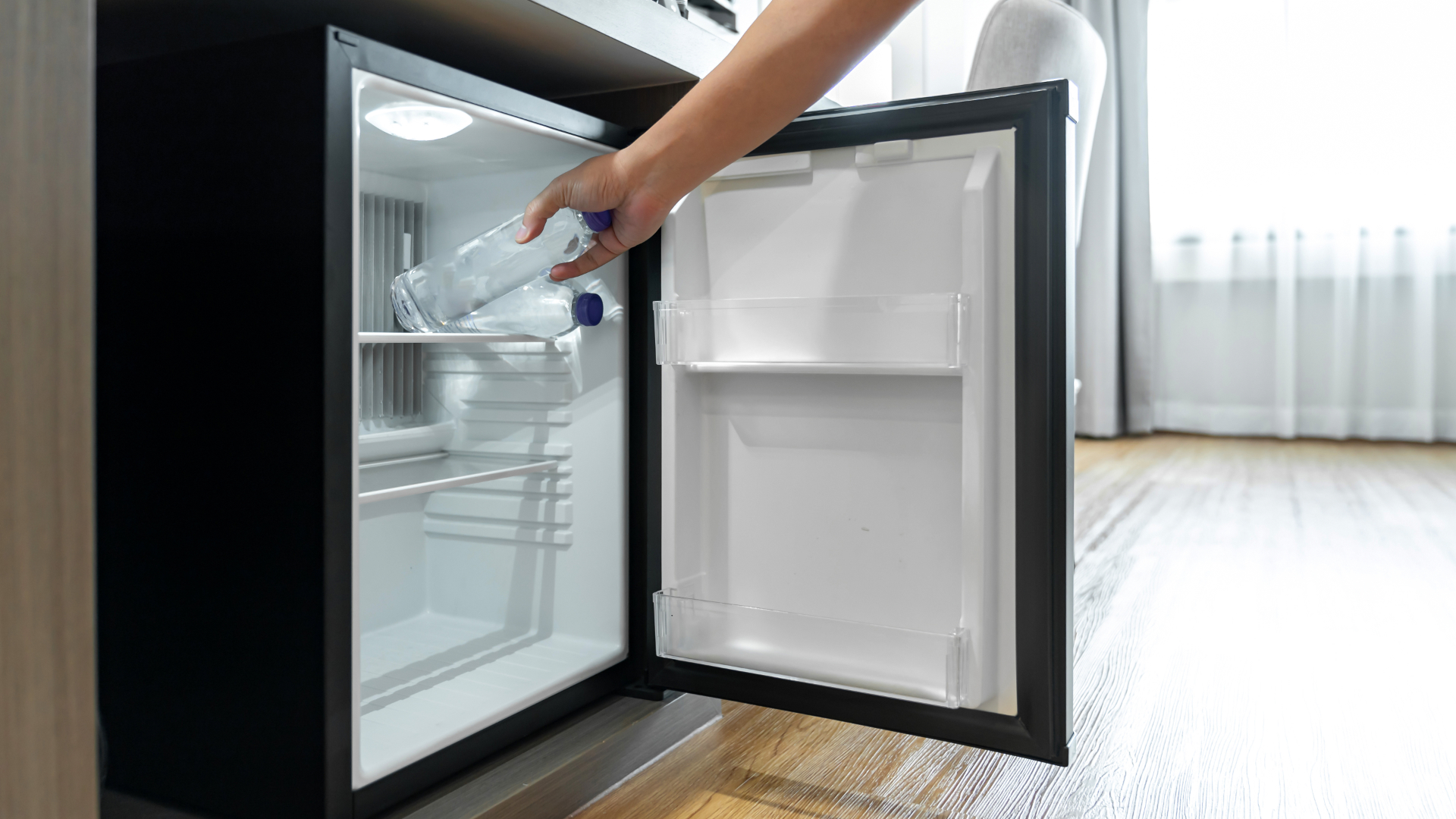Is your mini fridge failing to keep your drinks cold or your snacks fresh? You’re not alone.
A mini fridge that’s not cooling can be frustrating, especially when you’re counting on it to keep things chilled. But don’t worry, there are simple solutions that might get your fridge back to working order quickly. Whether it’s a minor issue or something more complex, we’ve got the tips and tricks to help you troubleshoot and fix the problem.
Dive into the rest of this article to discover how you can reclaim your cool space and ensure your mini fridge is running efficiently again. After all, a cold drink is just a few steps away!

Credit: www.reddit.com
Common Causes
Mini fridges are handy for small spaces. But sometimes, they stop cooling. It’s frustrating. Understanding the common causes can help you fix the issue. Many problems are easy to solve. Let’s explore some typical reasons your mini fridge may not cool.
Power Supply Issues
Check if your mini fridge is plugged in. Look at the power cord for damage. Verify the outlet is working. A tripped circuit breaker can also cause problems. Ensure the breaker is not off. Power supply issues are common and easy to fix.
Thermostat Problems
The thermostat regulates the fridge’s temperature. It might be set too high. Adjust the thermostat to a cooler setting. Sometimes, the thermostat itself is faulty. If adjusting doesn’t help, consider a replacement. Thermostat issues need attention for effective cooling.
Blocked Ventilation
Mini fridges need airflow to cool properly. Check for any blockage around the vents. Items inside the fridge can block airflow. Ensure the fridge is not too full. Proper ventilation is key for keeping things cool.

Credit: fleetappliance.com
Quick Checks
Experiencing trouble with a mini fridge not cooling can be frustrating. Before calling for repairs, try these quick checks. They might save you time and money. These simple steps can often resolve the issue.
Inspect Power Cord
A disconnected power cord can cause cooling problems. Ensure it’s plugged in securely. Look for any damage or fraying. A damaged cord might need replacement. Check the outlet by plugging in another device. If it works, the outlet is fine.
Adjust Thermostat Settings
Incorrect thermostat settings can affect cooling. Check the temperature dial inside the fridge. It should be set to a colder setting. Sometimes settings change accidentally. Adjust it to see if cooling improves. Wait a few hours after adjusting.
Ensure Proper Ventilation
Blocked vents can hinder cooling efficiency. Check the vents inside the fridge. They should be clear and unobstructed. Space around the fridge is important too. Ensure there’s enough room for air circulation. Move items away from the back and sides.
Advanced Troubleshooting
When your mini fridge isn’t cooling, advanced troubleshooting can help. This process dives deep into the fridge’s components. It requires careful examination. Each step will guide you to potential solutions. Understanding these elements is essential for efficient cooling.
Test Compressor Function
The compressor is vital for cooling. First, listen for any unusual noises. These could indicate a problem. Next, check if the compressor is running. Touch it to feel vibrations. No vibrations might suggest it’s not working. Use a multimeter to test electrical continuity. This ensures power reaches the compressor. Replace the compressor if it shows no continuity.
Examine Refrigerant Levels
Refrigerant is crucial for maintaining cold temperatures. If levels are low, cooling will suffer. Check for any leaks around the fridge. A hissing sound could indicate a refrigerant leak. You can’t refill refrigerant yourself. It requires professional service. Regular maintenance can prevent leaks. This ensures optimal refrigerant levels.
Inspect Evaporator Coils
Evaporator coils remove heat from inside the fridge. Frost buildup can hinder this process. First, unplug the fridge. Then, locate the coils, usually at the back. Check for frost or ice accumulation. Gently defrost the coils if needed. Clean the coils with a soft brush. This improves airflow and cooling efficiency.

Credit: www.reddit.com
Diy Fixes
Facing a mini fridge that’s not cooling? Start by checking the thermostat settings. Ensure the fridge is plugged in properly. Clean dust off the coils and ensure air can flow around the appliance. These simple DIY steps might restore its cooling efficiency.
Having a mini fridge that stops cooling can be frustrating, especially when it’s filled with your favorite snacks and drinks. Before you rush to call a professional, there are some simple DIY fixes you can try. These can not only save you money but also give you the satisfaction of solving the problem yourself. Let’s delve into some practical steps to get your mini fridge back to its optimal performance.Replace Faulty Thermostat
If your mini fridge isn’t cooling, the thermostat might be the culprit. Start by unplugging the fridge for safety. Test the thermostat with a multimeter to see if it’s working properly. If not, replacing it could be a quick fix. Thermostats are usually affordable and available at appliance stores or online. Changing it requires only basic tools and a bit of patience. Remember, following the manufacturer’s instructions carefully will ensure you don’t damage any parts. Always double-check your work before plugging the fridge back in.Clear Airflow Blockages
Blocked airflow can cause your mini fridge to struggle with cooling. Check if anything is blocking the vents inside the fridge. Items packed too tightly can restrict air circulation, leading to warm spots. Consider reorganizing your fridge for better airflow. Ensure there’s enough space between the items for the air to move freely. By doing this, you’ll optimize the cooling efficiency and keep your food fresh longer.Clean Coils And Components
Dust and dirt on the coils can significantly impact cooling performance. Unplug your fridge and locate the coils, which are usually at the back or bottom. Use a vacuum cleaner or a coil brush to remove dust and debris from the coils. Cleaning should be done gently to avoid damaging any components. While you’re at it, check for dust build-up on the fan and other parts. Regular cleaning can improve efficiency and extend the life of your fridge. Before you call for help, give these DIY fixes a try. Often, a little bit of maintenance is all it takes to get your mini fridge cooling like new again. Have you tried any of these fixes before? What worked best for you? Share your experiences in the comments!When To Call A Professional
A mini fridge not cooling can signal bigger issues. Strange noises or constant cycling might need expert help. If basic troubleshooting fails, calling a professional ensures safe and efficient repairs.
Is your mini fridge not cooling properly? Sometimes, even after trying all the DIY tips, your fridge might still fail to chill your drinks or keep your snacks fresh. It’s crucial to know when it’s time to call a professional. This decision could save you from further damage and ensure your fridge’s longevity. Let’s dive into the signs that indicate it’s time to get expert help.Persistent Cooling Issues
If your mini fridge continues to struggle with cooling despite your best efforts, it might be time to seek professional assistance. You might have tried adjusting the thermostat or cleaning the coils, but the problem persists. A professional can diagnose issues like a faulty compressor or thermostat that you can’t fix on your own. Don’t wait until it stops working completely; act before your food goes bad.Complex Repairs Needed
Some repairs are simply beyond the scope of DIY fixes. Have you ever opened up the back of your fridge only to be overwhelmed by the maze of wires and components? If the repair involves electrical components, it’s best to leave it to the experts. A professional can handle complex parts like the evaporator fan motor without risking further damage.Safety Concerns
Your safety should always come first. Handling electrical appliances without proper knowledge can be dangerous. If you suspect an electrical fault or notice sparks, it’s essential to call a professional immediately. Remember the time you tried fixing an appliance and ended up with a small shock? Avoid putting yourself in harm’s way. Professionals have the right tools and expertise to address these issues safely. When dealing with a mini fridge that won’t cool, ask yourself: Is this something I can handle, or should I call an expert? Knowing when to step back can save you time and ensure your appliance is in the best hands.Preventive Maintenance Tips
Keeping your mini fridge in top shape ensures it runs smoothly. Regular maintenance prevents many common cooling issues. These simple tips can extend its life and efficiency.
Regular Cleaning Routine
Cleaning your mini fridge often helps it cool better. Dust and dirt block airflow and cause cooling problems. Use a soft cloth to wipe down surfaces. Focus on the interior and exterior parts. Don’t forget the coils at the back. Dusty coils make the fridge work harder. Clean them monthly with a vacuum or brush.
Optimal Temperature Settings
Set the fridge to the right temperature for best cooling. Keep the fridge between 37°F to 40°F. The freezer should be set at 0°F. These settings preserve food and save energy. Check the thermostat regularly. Make sure it stays in the correct range.
Avoid Overloading
Overloading the fridge can block cool air. Leave space between items to allow air circulation. A packed fridge uses more energy and cools less efficiently. Store only what you need. Keep heavy items on lower shelves. This helps maintain a steady temperature inside.
Frequently Asked Questions
Why Is My Mini Fridge Not Cooling?
Check the power source first. Ensure it’s plugged in. Inspect the thermostat settings. Clean the condenser coils.
How Do I Fix A Mini Fridge Not Cooling?
Unplug the fridge. Clean the coils and check the door seal. Adjust thermostat settings. Seek professional help if needed.
What Causes A Mini Fridge To Stop Cooling?
Dirty coils, faulty thermostat, blocked vents, or door seal issues can cause cooling problems. Regular maintenance helps.
Can A Blocked Vent Affect Fridge Cooling?
Yes, blocked vents restrict airflow. Ensure vents are clear for proper cooling. Check and clean them regularly.
Should I Repair Or Replace A Mini Fridge Not Cooling?
Check warranty first. Simple issues can be fixed. If major, consider replacement. Consult a professional for advice.
Conclusion
A mini fridge not cooling can be frustrating. Troubleshoot common issues first. Check the power supply. Ensure the thermostat is set correctly. Clean the condenser coils for better performance. Examine the door seal. It should close tightly. Consider the placement of your fridge.
Avoid placing it near heat sources. If problems persist, consult a professional. Regular maintenance helps prevent issues. Keep your fridge clean and organized. This ensures efficient cooling. Remember, a well-maintained fridge lasts longer. Stay cool and enjoy your chilled snacks!
